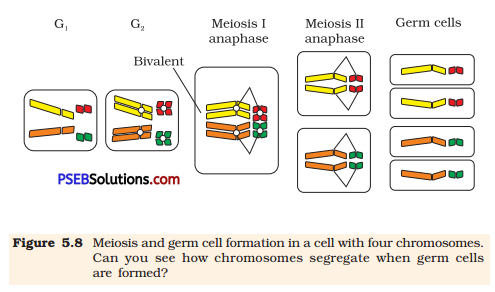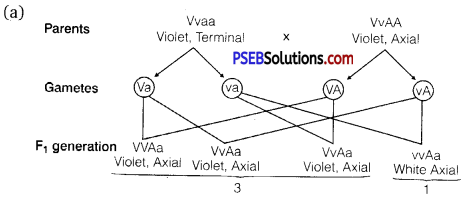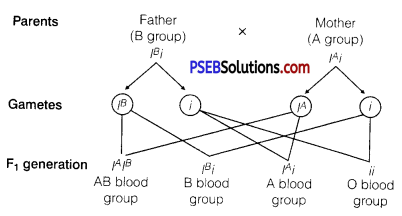Punjab State Board PSEB 12th Class Biology Important Questions Chapter 5 Principles of Inheritance and Variation Important Questions and Answers.
PSEB 12th Class Biology Important Questions Chapter 5 Principles of Inheritance and Variation
Question 1.
Mention any two contrasting traits with respect to seeds in pea plant that were studied by Mendel.
Answer:
Round/Wrinkled, Yellow/Green.
Question 2.
Name the type of cross that would help to find the genotype of a pea plant bearing violet flowers.
Answer:
Test Cross.
Question 3.
State a difference between a gene and an allele.
Answer:
Gene is a unit of heredity passed from’one generation to next generation and determine the expression of any morphological or physiological inheritable character of an organism.
Alleles are alternative form of a gene, occupying the same position on homologous chromosomes and affecting the alternative forms (contrasting traits) of the same character.
![]()
Question 4.
A garden pea plant (A) produced inflated yellow pod, and another plant (B) of the same species produced constricted green pods. Identify the dominant traits.
Answer:
Inflated green pod is the dominant trait.
Question 5.
Mention the type of allele that expresses itself only in homozygous state in an organism.
Answer:
Recessive allele.
Question 6.
A garden pea plant produced axial white flowers. Another of the same species produced terminal violet flowers. Identify the dominant traits.
Answer:
Axial, violet flower.
Question 7.
What are ‘true breeding lines’ that are used to study inheritance pattern of traits in plants?
Answer:
True breeding lines are plants which have undergone continuous self-pollination for several generations. These are homozygous for traits.
Question 8.
Name the stage of cell division where segregation of an independent pair of chromosomes occurs.
Answer:
Anaphase-I of Meiosis-I.
![]()
Question 9.
A male honeybee has 16 chromosomes whereas its female has 32 chromosomest Give one reason.
Answer:
A male honeybee with 16 chromosomes develops parthenogenetically from an unfertilised egg and is haploid (n) whereas the female honeybee with 32 chromosomes develops from a fertilised egg, the zygote and is diploid (2n).
Question 10.
Why is it that the father never passes on the gene for haemophilia to his sons? Explain.
Answer:
Haemophilia is a sex-linked recessive disease and the defective gene is present on X chromosome only and not on Y chromosome. Father never passes X chromosome to the son as father only contributes Y chromosome to the son.
Question 11.
Write the chromosomal defect in individuals affected with Klinefelter’s syndrome.
Answer:
Klinefelter syndrome is caused due to the presence of an additional X-chromosome in the genotype of an individual i.e., 44 + XXY.
Question 12.
State the chromosomal defect in individuals with Turner’s syndrome.
Answer:
In Turner’s syndrome, the karyotype of the individual is 44 + XO. The X-chromosome is missing. It is due to the non-disjunction of X-chromosomes during oogenesis/spermatogenesis.
Short answer type questions
Question 1.
Mendel published his work on inheritance of characters in 1865, but it remained unrecognised till 1900. Give three reasons for the delay in accepting his work.
Answer:
- The communication was not easy in those days and his work could not be widely publicised.
- His concept of genes as stable and discrete units that controlled the expression of traits and of the pair of alleles which did not ‘blend’ each other was not accepted by contemporaries as an explanation for the apparently continuous variation seen in nature.
- Mendel’s approach of using mathematics to explain biological phenomena was totally new and unacceptable to many of the biologists of his time.
- Though Mendel’s work suggested that factors (genes) were discrete units, he could not provide any physical proof for the existence of factors what they were made of.
![]()
Question 2.
The pedigree chart given below shows a particular trait which is absent in parents but present in the next generation irrespective of sexes.
Draw your conclusion on the basis of the pedigree. [NCERT Exemplar]

Answer:
The pedigree chart shows that the trait is autosomal linked and recessive in nature. But, the parents are carriers (i.e. heterozygous) hence, among the offsprings only few show the trait irrespective of sex. The other offsprings are either normal or carrier.
Question 3.
What is Down’s syndrome? Give its symptoms and cause. Why is it that the chances of having a child with Down’s syndrome increases if the age of the mother exceeds forty years?
[NCERT Exemplar]
Answer:
Down’s syndrome is a human genetic disorder caused due to trisomy of chromosome 21. Such individuals are anploid and have 47 chromosomes (2n + 1). The symptoms include mental retardation, growth abnormalities, constantly open mouth, dwarfness, etc. The reason for the disorder is the non-disjunction (failure to separate) of homologous chromosome of pair 21 during meiotic division in the ovum.
The chance of having a child with Down’s syndrome increase with the age of the mother (40+) because ova are present in females since their birth and therefore older cells are more prone to chromosomal non-disjunction because of various physicochemical exposures during the mother’s life-time.
Question 4.
Differentiate between male and female heterogamety.
Answer:
In male heterogamety, the male is heteromorphic and have XY or XO type of sex chromosomes and produce two types of sperms, 50% with X- chromosome and 50% with Y-chromosome or none. The sex of the offspring depends upon the type of sperm, which fuses with egg e.g., mammals, Drosophila, grasshopper.
In female heterogamety, the female is heteromorphic and heterogametic and have ZW or ZO type of sex chromosomes and produce two types of eggs. The sex of the offspring depends upon the type of egg, which is fertilised, e.g., bird and some reptiles, butterflies and moths.
Question 5.
Explain mechanism of sex-determination in birds.
Answer:
Sex-determination in birds is opposite to human beings. Here the females contain heteromorphic sex chromosomes (AA + ZW) while the males have homomorphic (AA + ZZ) chromosomes. Thus, there is female heterogamety. The females are heterogametic and produce two types of eggs (A + Z) and (A + W). The male gametes are of one type (A + Z).
![]()
Question 6.
Why are human females rarely haemophilic? Explain. How do haemophilic patients suffer?
Answer:
Haemophilia is a sex-linked recessive disorder. The females have XX chromosomes and the males have XY chromosomes. If one of the two X chromosomes is normal, she remains a carrier and not diseased. Females will haemophilic only when both the X chromosomes carry the haemophilia gene, and this is possible only when the mother is a carrier and father is haemophilic. Haemophilic patients suffer from non-stop bleeding and nd clotting.
Question 7.
How do genes and chromosomes share similarity from the point of view of genetical studies? [NCERT Exemplar]
Answer:
By 1902, the chromosome movement during meiosis had been worked out.
Walter Sutton and Theodore Boveri (1902) noted that the behaviour of chromosomes was parallel to the behaviour of genes and used chromosome movement to explain Mendel’s laws.
They studied the behaviour of chromosomes during mitosis (equational division) and during meiosis (reduction division). The chromosomes as well as genes occur in pairs and the two alleles of gene pair are located on homologous sites of homologous chromosomes.

Chromosomes segregate when germ cells are formed.
Question 8.
Write short notes on –
(i) Phenylketonuria
(ii) Aneuploidy
Answer:
(i) Phenylketonuria : It is an inborn error of metabolism. The affected individual lack an enzyme called phenylalanine hydroxylase that converts the amino acid phenylalanine into tyrosine. As a result, phenylalanine gets accumulated and converted into phenylpyruvic acid and other derivatives in brain, causing mental retardation. These are also excreted through urine due to their absorption by kidney.
(ii) Aneuploidy: It is a phenomenon which occurs due to non¬disjunction resulting into gain or loss of one or more chromosomes, during meiosis.
Long answer type questions
Question 1.
(a) A garden pea plant bearing terminal, violet flowers, when crossed with another pea plant bearing axial, violet flowers, produced axial, violet flowers and axial, white flowers in the ratio of 3 : 1. Work out the cross showing the genotypes of the parent pea plants and their progeny.
(b) Name and state the law that can be derived from this cross and not from a monohybrid cross.
Answer:

(b) Law of Independent Assortment : When two pairs of traits are combined in a hybrid, segregation of one pair of characters is independent of the other pair of character.
Question 12.
(a) Write the blood group of people with genotype IAIB. Give reasons in support of your answer.
(b) In one family, the four children each have a different blood group. Their mother has blood group A and their father has blood group B. Work out a cross to explain how it is possible.
Answer:
(a) Blood group AB. Both the alleles IA and IB are co-dominant and express themselves completely.
(b) A cross is carried out between heterozygous father (of blood group B) and heterozygous mother (of blood group A) to get four children with different blood groups.

All the four blood groups are controlled by three allelic genes IA, IB, i
and thus it shows phenomena of multiple allelism. Both IA and IB are dominant over i. However, when together, both are dominant and show the phenomena of co-dominance forming the blood group AB. Six genotypes are possible with combination of these three alleles.
Question 3.
(A) Why are colourblindness and thalassemia categorised as Mendelian disorders? Write the symptoms of these diseases seen in people suffering from them.
(B) About 8% of human male population suffers from colourblindness whereas only about 0.4% of human female population suffers from this disease. Write an explanation to show how it is possible.
Answer:
(A) Colourblindness and thalassemia are categorised as Mendelian disorders because they are (i) due to alteration or mutation in a single gene (ii) transmission to the offspring follow principle of inheritance (iii) can be studied by pedigree analysis.
Symptoms of Colourblindness
(a) Difficulty in distinguishing between colours
- Protanopia-red colourblindness
- Deuternopia-green colourblindness
- Tritanopia-blue colourblindness
(b) Rapid eye movement (in rare cases)
(c) Inability to see shades or tones of the same colour.
(d) In rare cases, some people see only black, white and grey.
Symptoms of Thalassemia
(a) Formation of abnormal haemoglobin molecules resulting into haemolytic anaemia.
(b) Slow growth, delayed puberty.
(c) Bones become wider than normal, brittle and break easily
(d) Poor appetite
(e) A pale and listless appearance
(f) Dark urine
(g) Enlarged spleen, liver or heart.
(B) Colourblindness is a recessive sex-linked disorder in which the patient cannot distinguish red-green colour. The gene for colourblindness is present on X-chromosome. Presence of colourblindness in 8% human male population, is due to the presence of a single X-chromosome in male. There is no chance of dominant and recessive condition, as there is a single gene. Hemizygous condition is enough for the occurrence of defect in males. In females, due to presence of two X-chromosomes, the single gene of colourblindness cannot express and such females are carriers (XXc) for a female to be colourblind, both of her X-chromosome, carry gene for colourblindness(XcXc).
